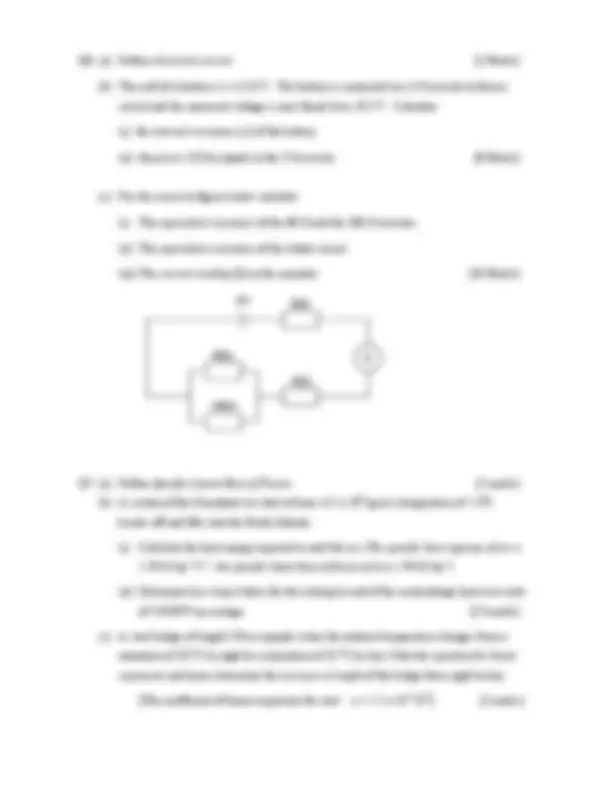




Study with the several resources on Docsity

Earn points by helping other students or get them with a premium plan


Prepare for your exams
Study with the several resources on Docsity

Earn points to download
Earn points by helping other students or get them with a premium plan
Community
Ask the community for help and clear up your study doubts
Discover the best universities in your country according to Docsity users
Free resources
Download our free guides on studying techniques, anxiety management strategies, and thesis advice from Docsity tutors
Main points of this past exam are: Thermometric Property, Additional Device, Individual Focal Lengths, Longitudinal Wave, Transverse Wave, Wave Equation, Wave Velocity, Equation for Particle Velocity, First Order Red Line
Typology: Exams
1 / 4

This page cannot be seen from the preview
Don't miss anything!



Answer (^) FIVE questions (^) only. Show ALL working to gain full marks. Assume: g = 10.0 ms -
Examiners: Prof. P. O Donoghue Mr. P. Anthony Dr. M. E. Woods
Q1. (a) (i) What is a thermometric property of a thermometer?
(ii) State the thermometric property of ONE named thermometer. (4 marks) (b) The tungsten filament of a lamp has a length of 0.6 m and a radius of 20 μm. The power rating of the lamp is 50 W. Assume that the wire emits radiation equivalent to 80 % of that of a black body radiator at the same temperature.
(ii) Estimate the temperature of the filament. Assume that absorption of radiation from the surroundings is negligible. (9 marks) [Stefan’s Constant σ = 5.7 x 10-8^ Wm-2^ K -4^ ]
(c) A cavity wall of a house with an air gap emits 3.0 kW of heat through it walls which have an area of 90 m^2 when the internal temperature of the house is 28 o^ C and the external temperature is 3 o^ C. Determine the U-value of the wall. [4 marks]
Q2 (a) (i) Sketch a fully-labelled ray diagram of a refracting astronomical telescope operating in normal adjustment incorporating two converging lenses of focal length f (^) o and f (^) e [f (^) o > f (^) e]. Indicate all relevant distances, angles and images. [6 marks] (ii) State the location , orientation and nature of the final image. [3 marks] (iii) State the magnification equation for the telescope. [1 mark] (iv) What additional device is incorporated into a terrestrial telescope? How does this device affect the final image? [2 marks] (b) An object is placed 50 cm from a thin converging lens (lens1) and produces a real image at a distance of 75 cm from the lens. A second thin lens (lens 2) is then placed in contact with the first lens and the focal length of the combination is measured to be fc = + 80 cm (i) Calculate the individual focal lengths of the two lenses. [5 marks] (ii) State with a reason whether the second lens is diverging or converging. [1 mark] (iii) Calculate the magnification of lens1. [2 marks]
Q3 (a) Define the following categories of wave and name ONE physical property , which belongs to that type: (i) longitudinal wave (ii) transverse wave. [5 marks]
(b) A boat traveling along a river generates a progressive wave, whose displacement y is given by: y = Asin( 2 π (ft + x λ )) The water wave has a frequency of 0.3 Hz, an amplitude of 7.5 cm and a wavelength of 80 cm. (i) Sketch a labelled diagram of displacement (y) versus position (x) for the condition t = 0 s. Indicate the wavelength and amplitude on the plot. [4 marks] (ii) State the wave equation and hence determine the wave velocity (units: ms-1^ ). [4 marks] (iii) Determine the period (T) of the wave. [2 marks] (iv) State the equation for the particle velocity and determine its value (units: ms -1^ ) for x = 0 cm, t = 5.0 s. [5 marks]
Q6 (a) Define electrical current. [2 Marks]
(b) The emf of a battery is ε =12.0 V. The battery is connected to a 3 Ω resistor to form a circuit and the measured voltage is now found to be 10.2 V. Calculate: (i) the internal resistance [r] of the battery (ii) the power [P] dissipated in the 3 Ω resistor. [8 Marks]
(c) For the circuit in figure below calculate: (i) The equivalent resistance of the 60 Ω and the 100 Ω resistors. (ii) The equivalent resistance of the whole circuit. (iii) The current reading [I] on the ammeter. [10 Marks]
Q7. (a) Define Specific Latent Heat of Fusion. [2 marks] (b) A section of the Greenland ice sheet of mass 6.5 x 10 6 kg at a temperature of -15 o^ C breaks off and falls into the North Atlantic. (i) Calculate the heat energy required to melt the ice (The specific heat capacity of ice is 2.03 kJ kg-1o^ C -1^ ; the specific latent heat of fusion of ice is 334 kJ kg-1^ ). (ii) Determine how long it takes for the iceberg to melt if the surroundings heat it at a rate of 150 MW on average. [13 marks] (c) A steel bridge of length 250 m expands when the ambient temperature changes from a minimum of 10 o^ C by night to a maximum of 32 o^ C by day. State the equation for linear expansion and hence determine the increase in length of the bridge from night to day. [The coefficient of linear expansion for steel α = 1.2 x 10-5^ K -1^ ] [5 marks]